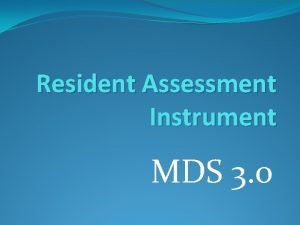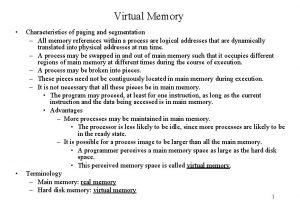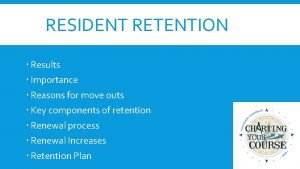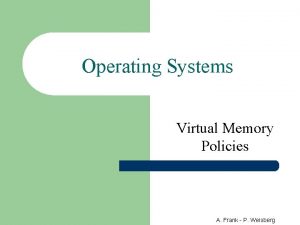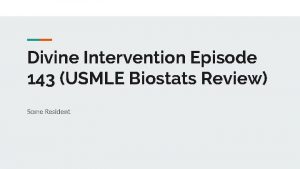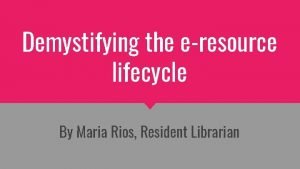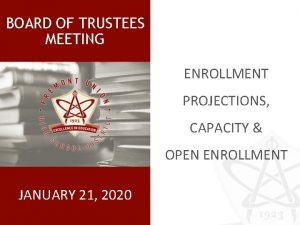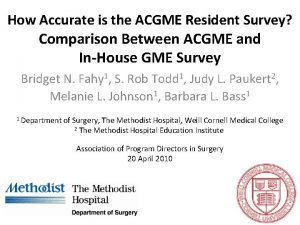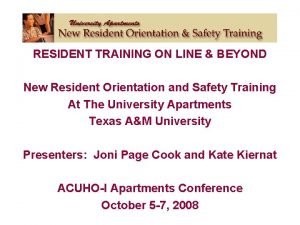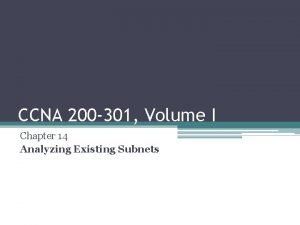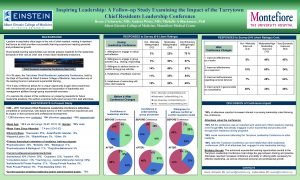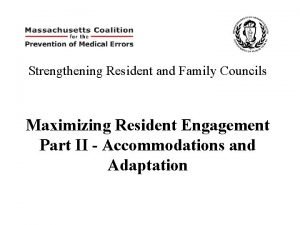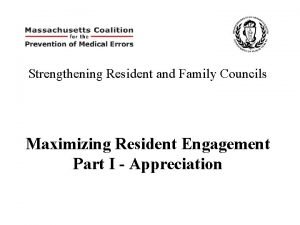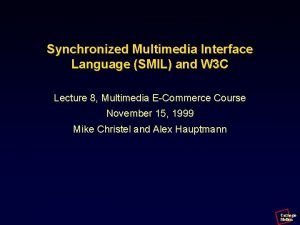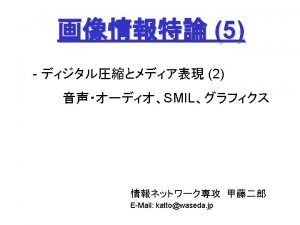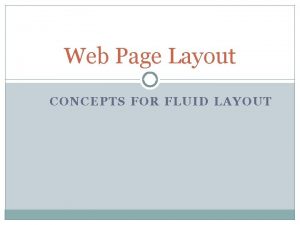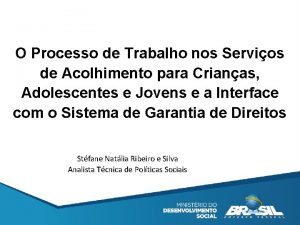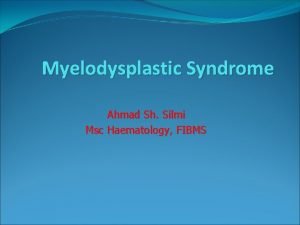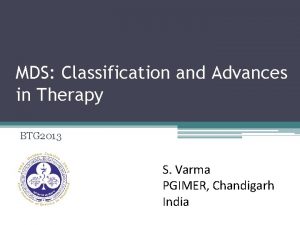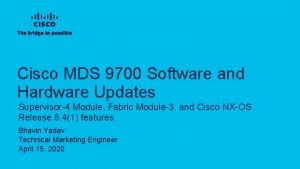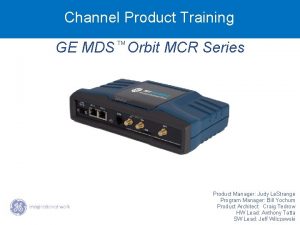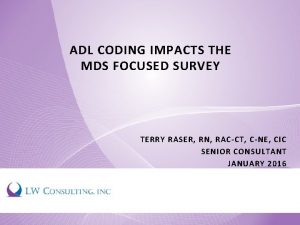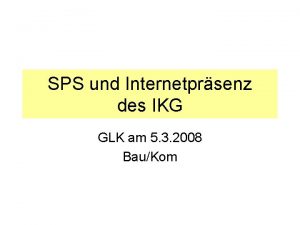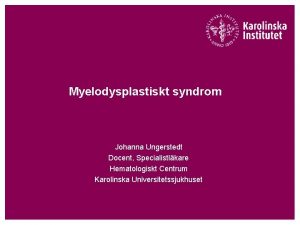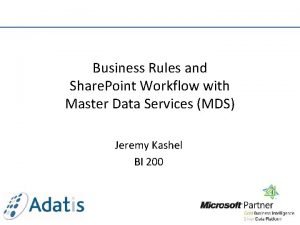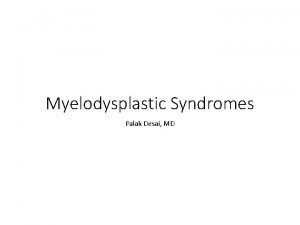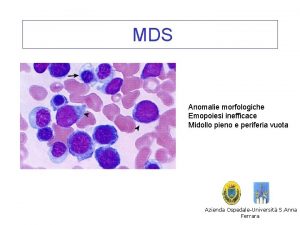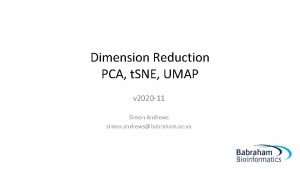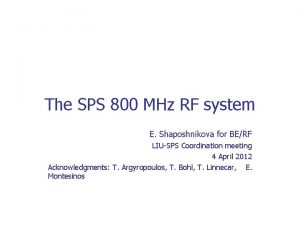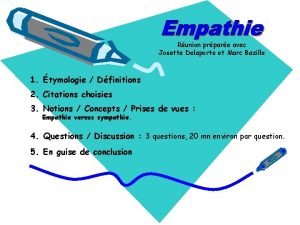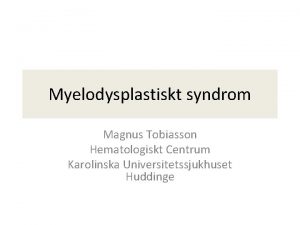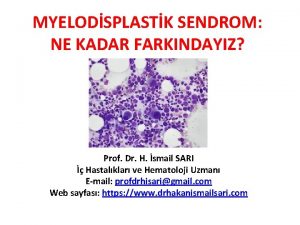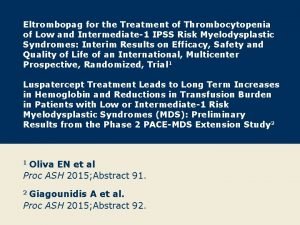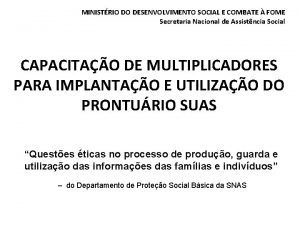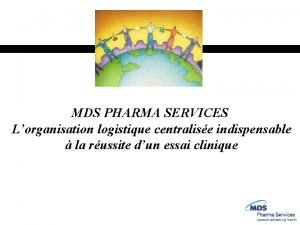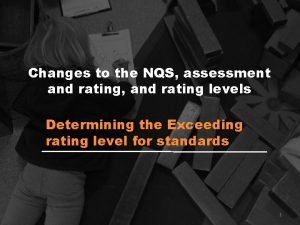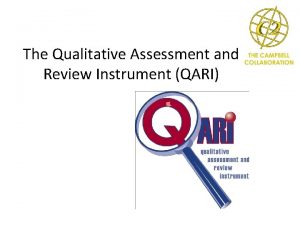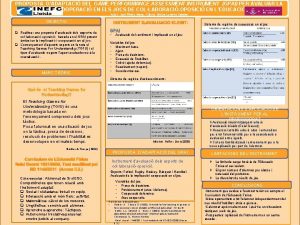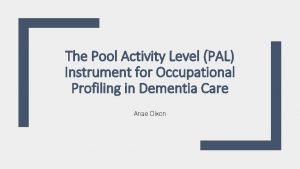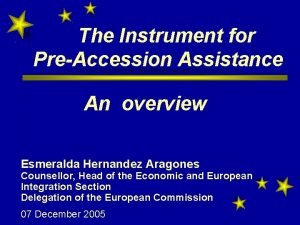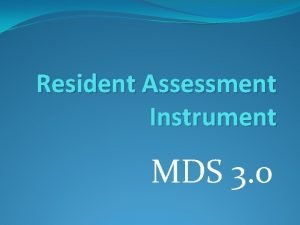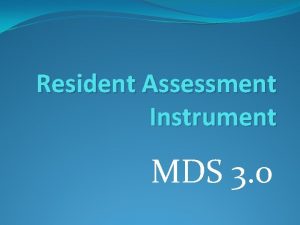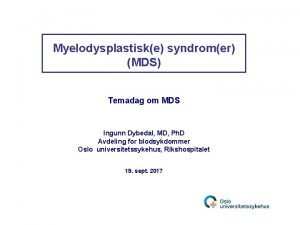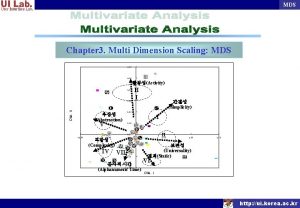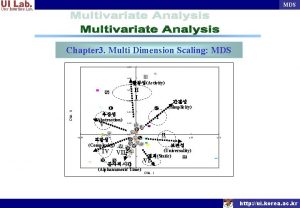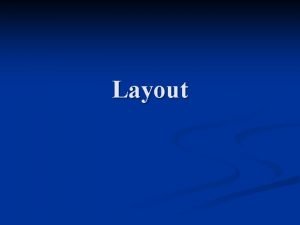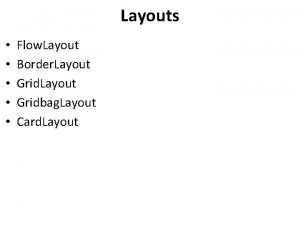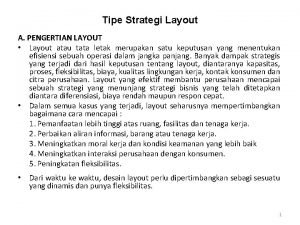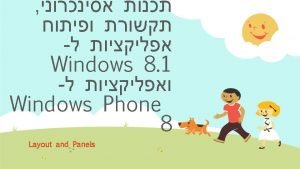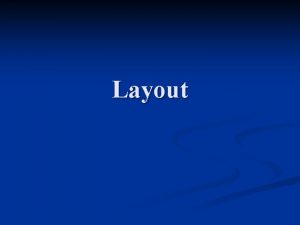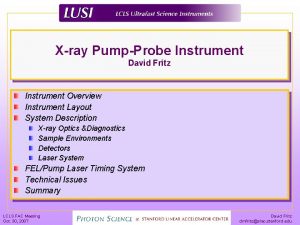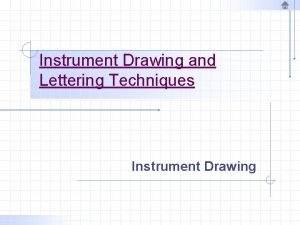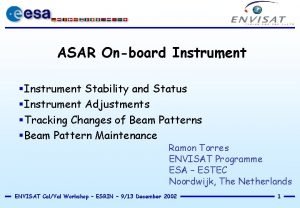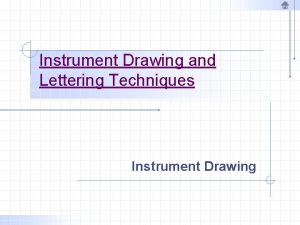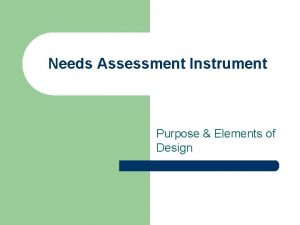Resident Assessment Instrument MDS 3 0 Layout of














































































- Slides: 78

Resident Assessment Instrument MDS 3. 0

Layout of RAI Manual �Chapter 1 – RAI �Chapter 2 – Assessments �Chapter 3 – Item-by-Item Guide �Chapter 4 – Care Area Assessment (CAA) Process and Care Planning �Chapter 5 – Submission and Correction �Chapter 6 – Skilled Prospective Payment System (PPS) �You can access the manual at: http: //www. cms. gov/Medicare/Quality-Initiatives-Patient-Assessment. Instruments/Nursing. Home. Quality. Inits/MDS 30 RAIManual. html

Chapters �Chapter 1 contains important information about the content and completion of the RAI and how it serves the nursing facility staff in problem identification. There is also information about protecting the privacy of the MDS information, among other topics. �Chapter 2 details scheduling, completion and submission timeframes for OBRA and PPS purposes. There are lots of definitions in this chapter and some very useful charts that outline timeframes related to scheduling, completion and submission. �Chapter 3 contains directions for completing each and every MDS item. It is a must that this information be used to guide assessments; simply referring to the form (or item set) for directions will lead to inaccurate coding.

Chapters cont. �Chapter 4 is titled Care Area Assessment (CAA) Process and Care Planning – here you will find information about the RAI process and how the CAAs provide the critical link between the MDS and the care plan. �Chapter 5 details Submission and Correction of the MDS Assessments. �Chapter 6 outlines the Medicare Skilled Nursing Facility Prospective Payment System (SNF PPS) – there is some overview information about SNF PPS in this chapter as well as very detailed information about the RUG-IV system.

Appendices �Appendix A – Glossary and Common Acronyms �Appendix B – SA & CMS RO RAI/MDS Contacts �Appendix C – Care Area Assessment (CAA) Resources �Appendix D – Interviewing to Increase Resident Voice �Appendix E – PHQ-9 Scoring Rules & Instruction for BIMS �Appendix F – Item Matrix �Appendix G – References �Appendix H – MDS 3. 0 Item Sets

CHAPTER 3: OVERVIEW OF THE ITEM-BY-ITEM GUIDE

Chapter 3 �Provides Item-by Item coding instructions for all required sections and items in the MDS version 3. 0 item set. �Goal is to facilitate the accurate coding of the resident assessment and to provide assessors with the rationale and resources to optimize resident care and outcomes. �Becoming familiar with the MDS recommended approach is essential for an accurate assessment.

Standard Coding Conventions �With the exception of certain items, the look-back period does not include the hospital stay or days prior to admission. �Skip patterns – Instructions direct the assessor to “skip” items and go on to another. When there is a skip pattern, leave the item blank and move to the next item as directed. �Use a check mark for boxes when instructions state to “check all that apply”; otherwise leave the box blank �Almost all items allow a dash indicating and item was not assessed. �Resident should be primary source of information, when possible. �With measurements, if count or measurement greater than number of boxes, place a 9 in each box, i. e. 999 for 1010.

Sections and Intent �A - Identification Information - Obtain key information to uniquely identify each resident, nursing home, type of record, and reasons for assessment. �B - Hearing, Speech, and Vision - Document the resident’s ability to hear, understand, and communicate with others and whether the resident experiences visual, hearing or speech limitations and/or difficulties. �C - Cognitive Patterns - Determine the resident’s attention, orientation, and ability to register and recall information. �D – Mood - Identify signs and symptoms of mood distress.

Sections (cont. ) �E – Behavior - Identify behavioral symptoms that may cause distress or are potentially harmful to the resident, or may be distressing or disruptive to facility residents, staff members or the environment. �F - Preferences for Customary Routine and Activities - Obtain information regarding the resident’s preferences for his or her daily routine and activities. �G - Functional Status - Assess the need for assistance with activities of daily living (ADLs), altered gait and balance, and decreased range of motion. �H - Bladder and Bowel - Gather information on the use of bowel and bladder appliances, the use of and response to urinary toileting programs, urinary and bowel continence, bowel training programs, and bowel patterns.

Sections (cont. ) �I - Active Disease Diagnosis - Code diseases that have a relationship to the resident’s current functional, cognitive, mood or behavior status, medical treatments, nursing monitoring, or risk of death. �J - Health Conditions - Document health conditions that impact the resident’s functional status and quality of life. �K - Swallowing/Nutritional Status - Assess conditions that could affect the resident’s ability to maintain adequate nutrition and hydration. �L - Oral/Dental Status - Record any oral or dental problems present.

Sections (cont. ) �M - Skin Conditions - Document the risk, presence, appearance, and change of pressure ulcers as well as other skin ulcers, wounds or lesions. Also includes treatment categories related to skin injury or avoiding injury. �N – Medications - Record the number of days that any type of injection, insulin, and/or select medications was received by the resident. �O - Special Treatments and Procedures - Identify any special treatments, procedures, and programs that the resident received during the specified time periods. �P – Restraints - Record the frequency that the resident was restrained by any of the listed devices at any time during the day or night.

Sections (cont. ) �Q - Participation in Assessment and Goal Setting - Record the participation of the resident, family and/or significant others in the assessment, and to understand the resident’s overall goals. �V - Care Area Assessment (CAA) Summary - Document triggered care areas, whether or not a care plan has been developed for each triggered area, and the location of care area assessment documentation. �X - Correction Request - Request to modify or inactivate a record already present in the QIES ASAP database. �Z - Assessment Administration - Provide billing information and signatures of persons completing the

Section A – Identification Info �A 0050 – A 2400 Special Interest �A 0100 – A: XXXXXX, B: XXXXXX, C: XXXXXXX �A 0310 – A–G designate the type of assessment. �A 1600 – Entry Date �A 2300 – Assessment Reference Date (ARD)

Section B – Hearing, Speech, Vision �B 0100 – B 1200 Special Interest �B 0100 – Comatose or persistent vegetative state �B 0200 – Hearing: Assess with resident using normal hearing appliances. �B 0700 – Makes self understood: Assess using preferred language. �B 1000 – Vision: Assess using customary visual appliance.

Section C – Cognitive Patterns �C 0100 – C 1600 Special Interest �C 0100 – Should Brief Interview for Mental Status be Conducted (BIMS) ? Should attempt with most residents. Determine if resident rarely/never understood verbally or in writing or if the resident needs or wants an interpreter. �Ask the questions as written and follow the basic interview instructions. �Only record the first attempt. �Follow the skip pattern and complete Staff Assessment as directed.

Section D - Mood �D 0100 – D 0650 Special Interest �If resident rarely/never understood follow skip pattern and complete Staff Assessment as indicated. �The assessment simply records the presence or absence of specific mood indicators. IT DOES NOT DIAGNOSE. �Follow interviewing tips and techniques. �Notify appropriate clinical staff or mental health provider as indicated.

Section E - Behavior �E 0100 – E 1100 Special Interest � Identifies behavioral symptoms that may cause distress to the resident. � Focuses on the resident’s actions, not the intent of the behavior. � Code based on behaviors observed or thoughts expressed. � Follow the coding tips and special populations. � Do not assume refusal as rejection. Must know the resident’s preferences and goals to assess rejection. � Make sure the behavior occurred in the seven day look-back period.

Section F – Preferences / Activities �F 0300 – F 0800 Special Interest �Used to obtain information regarding the resident’s preferences for use developing the individualized care plan. �Interview the resident and interview family or significant other only if resident cannot answer. �Follow coding tips and special populations. �These answers are not subject to a particular look-back period due and may change over time related to changes in the resident’s preferences.

Section G – Functional Status �G 0110 – G 0900 Special Interest �Assesses assistance needed for completion of ADLs, altered gait and balance and decreased range of motion. �Follow coding tips and special populations �Code only assistance as given by Facility Staff as defined in the instructions. �Follow the “Rule of Three” when an activity occurs at varying levels and assistance.

Section H – Bladder and Bowel �H 0100 – H 0600 Special Interest �Follow coding tips and special populations. �Bladder and Bowel toileting programs must be: � Individualized, resident-specific based on assessment � Communicated to staff and the resident (as appropriate) � Response documented and re-evaluated as needed �Fecal Impaction is no longer tracked on the Quality Measures.

Section I – Active Diagnoses �I 0100 – I 8000 Special Interest �Code diseases that have a direct relationship to the resident’s current functional status, cognitive status, mood, or behavior status, medical treatments, nursing monitoring, or risk of death. �Determine if the diagnosis is active or inactive. �Must be physician (or NP, etc. ) documented in the last 60 days. �Follow coding tips.

Section J – Health Conditions �J 0100 – J 1900 Special Interest �Pain – 5 day look-back. Resident interview �Current Tobacco use – Electronic cigarettes not coded. �Prognosis – Life expectancy less than 6 months requires physician documentation (If receiving hospice services can code ‘yes’. �Falls- J 1700 A, B and C have look-backs beyond date of admission. �Fall is not result of external force. Intercepted fall is a fall. �Follow coding tips and instructions.

Section K – Swallowing/Nutrition �K 0100 – K 0700 Special Interest �Assess conditions that affect residents’ ability to maintain adequate nutrition and hydration. �Use industry standards when recording height of bilateral amputees. �Base weight on most recent measurement in last 30 days. �Planned weight loss can include physician prescribed planned diuresis. �Therapeutic diet must be ordered by a health care practitioner as part of a treatment for a disease or clinical condition. �Follow coding tips and instructions.

Section L – Oral/Dental Status �L 0200 Special Interest �To record any dental PROBLEMS during the look-back period. �Conduct exam of lips and oral cavity with dentures or partials removed. Visually observe and feel oral surfaces. �Follow coding tips and instructions.

Section M – Skin Conditions �M 0100 – M 1200 Special Interest �PU definitions used in the RAI Manual have been adapted from recommendations of the National Pressure Ulcer Advisory Panel 2007 (NPUAP). �Code the MDS according to the instructions in the RAI Manual not the NPUAP definitions. �Section M documents surgical wounds, venous, arterial or other diabetic ulcers and deep tissue injury as well as pressure ulcers. �Scabs and eschar are physically and chemically different. �Important to follow coding tips, instructions, examples and skip patterns.

Section N - Medications �N 0300 – No 410 Special Interest �Injections – Record number of days during the look-back period the resident received any type of medication, antigen, vaccine, etc. , by SQ, IM, or ID (intradermal) injection. �Insulin – Two Parts �N 0350 A – Number of days during the look-back insulin was received. �No 350 B – Number of days insulin orders were changed (does not include giving different doses according to sliding scale. Only count if the entire sliding scale order was changed). �Medications Received – Record number of days resident received any of the indicated medication categories. (Code according to the medication classification, not necessarily the reason it is given).

Section O – Tx/Procedures/Programs �O 0100 Special Interest �Section O 0100 has two parts – “While not a resident” and While a resident”. Check coding tips for correct coding. �Isolation – code only when resident requires strict isolation (according to CDC, not simply facility policy or physician order) or transmission-based precautions and single room isolation because of active infection and cannot have a roommate. Do not code if the precautions are standard precautions. The manual gives reference sites for CDC guidelines.

Oo 250 – Oo 300 �These sections document Influenza and Pneumococcal Vaccine information.

0 o 400 - Therapies �Code only medically necessary therapies that occurred after admission/readmission to the NH that were: �Ordered by a physician or other qualified professional based on a qualified therapist’s assessment and treatment plan. �Documented in the medical record. �Care planned and periodically evaluated to ensure therapy is effective. �May occur either inside or outside the facility.

Coding for Therapy �Individual Minutes �Enter the total minutes of therapy provided on an individual basis in the last 7 days. �Concurrent Minutes �Enter the total minutes of therapy that were provided on a concurrent basis in the last 7 days. Concurrent therapy is the treatment of 2 residents at the same time, when the residents are not performing the same or similar activities and both resident must be in the line of sight of the treating therapist or assistant for Medicare Part A. Part B residents may not be treated concurrently.

Coding (cont. ) �Group Minutes �Enter the total minutes of therapy provided in the last 7 days. Group therapy for Part A is the treatment of 4 residents regardless of payor source, performing the same or similar activities and are supervised by a therapist or assistant who is not supervising other individuals. For Medicare Part B, treatment of 2 or more regardless of payor source, at the same time. �Co-Treatment Minutes �Enter the total minutes of therapy each discipline of therapy administered to the resident in co-treatment sessions in the last 7 days.

Coding (cont. ) �Days – Enter the number of days therapy services were provided in the last 7 days. A “day” of therapy is defined as skilled treatment for 15 minutes or more during the day. Use total minutes of therapy provided (individual plus concurrent plus group) without adjustment to determine if the day is counted. �Therapy Start Date – Record the date the most recent therapy regimen started. This is the date the initial therapy evaluation is conducted regardless if treatment was rendered. �Therapy End Date – Record the date the most recent therapy regimen ended. This is the last date the resident received skilled therapy treatment.

0 o 420 Distinct Calendar Days �To record the number of calendar days the resident received each specific type of skilled therapy services for at least 15 minutes in the past 7 days.

O 0450 Resumption of Therapy �In cases where therapy resumes after the EOT OMRA is performed and the resumption of therapy date is no more that 5 consecutive calendar days after the last day of therapy provided, AND therapy services resumed at the same RUG-IV classification level that was in effect prior to the EOT OMRA, an EOT-R may be completed. �Determine when therapy will resume and code item O 0450 Bwith the date that therapy will resume

O 0500 Restorative Nursing �Refers to nursing interventions that promote the resident’s ability to adapt and adjust to living as independently and safely as possible. �May be started on a restorative nursing program when the resident is admitted to the facility with restorative needs, but is not a candidate formalized rehab, when restorative needs arise during a longer stay or in conjunction with formal rehab therapy.

Restorative (cont. ) �The following criteria must be met to code O 0500: �Measureable objective and interventions must be documented in the care plan and in the medical record. �Evidence of periodic evaluation by the licensed nurse must be present in the medical record. �Nursing assistants/aides must be trained in the techniques that promote resident involvement in the activity. �An RN or LPN must supervise the activities in a restorative nursing program. (The manual gives guidance, definitions and examples. )

O 0600 Physician Examinations �Physician Exams: �Includes MDs, ODs, podiatrists, dentists, NPs, Clinical Nurse Specialist (per State law). �Exam can be completed in the facility or at the physician’s office. Do not include exams conducted prior to admission/re-admission, ER visits or hospital observation stays. �Physician Examination can include partial or complete exam of the resident, monitoring for response to treatment, or adjusting treatment as a result of exam.

O 0700 Physician Orders �Includes written, telephone, fax or consultation orders for new or altered treatment. Does not include standard admission or re-admission orders, renewal orders, or clarifying orders without changes. �Administering a different sliding scale dose from a sliding scale order does not count as an order change. �PRN orders already on file is not counted when the PRN dose is activated. �Recertifications are renewals and do not count. �Multiple physicians with orders on the same day is counted as 1 physician visit and 1 day in which orders were changed. �Do not count orders written by a pharmacist.

Section P – Restraints (P 0100) Special Interest �Definition/CMS: Any manual method or physical or mechanical device, material or equipment attached or adjacent to the resident’s body that the individual cannot remove easily, which restricts freedom of movement or normal access to one’s body. (Any device must be individually assessed for effect on each resident. ) �Federal regulations nor CMS guidelines prohibit the use of physical restraints in nursing homes, except when they are imposed for discipline or convenience and are not required to treat the resident’s medical symptoms. �Exclude from this section items that are typically used in the provision of medical care, such as catheters, drainage tubes, casts, traction, leg, arm, neck or back braces, abdominal binders, and bandages that are serving in their usual capacity to meet medical needs.

Section Q – Participation in Assessment and Goal Setting �Q 0100 – Q 0600 Special Interest �Intent is to record the participation and expectations of the resident, family members, or significant other in the assessment and understand resident’s goals. �Section Q insures all have the chance to learn about home and community based services and the opportunity to receive LTC in the least restrictive setting. Answers to certain items will trigger a follow-up which gives the resident the chance to receive information, but additional assessment by the physician and LCA may be necessary to determine if discharge is appropriate. �Q 0490 - Is an option Not to continue to be asked on assessments other than comprehensive assessments.

Section V – CAA Summary �V 0100 – V 0200 Special Interest �Item V 0200 A documents which triggered care areas require further assessment, decision as to whether or not a triggered care area is addressed in the resident care plan AND the location and date of CAA documentation (this is a “map” to the CAA decision making documentation). �V 0200 B 1 – Signature of the RN coordinating the CAA process. �V 0200 B 2 – Date RN coordinating the CAA process certifies the CAAs have been completed.

Section X – Correction Request �X 0150 – X 01050 Special Interest The purpose of Section X is to identify an MDS record to be modified or inactivated. � Modification for: � Transcription errors � Data entry errors � Software product errors � Item coding errors � Other errors requiring modification � Inactivation used to move an existing record in the QIES ASAP database from an active file to an archive file. Used when the event did not occur. � Manual Deletion required only three reasons. � Refer to Chapter 5 for additional information.

Section Z – Assessment Administration �Z 0100 – Z 0400 Special Interest �Z 0100 – Z 0300 B values are used typically calculated by the software data entry product. �Tennessee is NOT a case-mix State and Tenn. Care payments are not based on MDS information so Z 0200 and Z 050 do not apply for TN. �Z 0400 – All staff who completed any part of the MDS must enter their signatures, titles, sections they completed and the date completed. This is an attestation of accuracy of their sections of the assessment. �Z 0500 – RN assessment coordinator signing to certify completeness of the assessment.

CHAPTER 4: CAA PROCESS AND CARE PLANNING

Overview of the RAI and CAAs �The MDS assessment identifies actual or potential areas of concern. �The RAI process supports efforts to further assess triggered areas of concern to determine if the findings require intervention. �These conclusions provide the basis for developing an individualized care plan for each resident.

CAA Process �Should help staff: �Consider each resident as a whole. �Identify areas of concern that need intervention. �Develop interventions to help improve, stabilize, or prevent decline according to the resident’s condition, choices and preferences. �Address the need and desire for other considerations, such as advanced care planning and palliative care.

What are the CAAs? � Triggered responses to items coded on the MDS specific to a resident’s possible problems, needs or strengths. The CAAs reflect conditions, symptoms, and other areas of concern that are common in nursing home residents. � Interpreting and addressing the care areas identified by the CATs (care area triggers) is the basis of the CAA process, and can help provide additional information for the development of an individualized care plan. � CMS does not mandate the use of a specific tool for completing the assessment of the triggered areas. � Facilities must use tools that are current and grounded in current clinical standards of practice, such as evidence-based or expert-endorsed research, clinical practice guidelines and resources. � Use of sound clinical problem solving and decision making skills is imperative.

20 CAAs 1. Delirium 2. Cognitive Loss/Dementia 3. Visual Function 4. Communication 5. Activity of Daily Living (ADL) 6. Urinary Incontinence and Functional/Rehabilitation Potential Indwelling Catheter 7. Psychosocial Well-Being 8. Mood State 9. Behavioral Symptoms 10. Activities 11. Falls 12. Nutritional Status 13. Feeding Tubes 14. Dehydration/Fluid Maintenance 15. Dental Care 16. Pressure Ulcer 17. Psychotropic Medication Use 18. Physical Restraints 19. Pain 20. Return to Community Referral

CAA Requirement �CAAs are not required for Medicare PPS assessments. �Required only for OBRA comprehensive assessments. �Must be completed when a Medicare PPS assessment is combined with an OBRA comprehensive assessment in order to meet the requirements for the OBRA comprehensive assessment.

What does the CAA process involve? �Identifying and clarifying areas of concern that are triggered by the MDS. �Evaluating the triggered care areas to determine the need for care plan interventions. �CATs (Care Area Triggers) identify conditions that need further evaluation through the CAA process. �Care area issues/conditions may result from a single underlying cause or from a combination of multiple factors. �Not all triggers identify deficits or problems. Some indicate areas of resident strengths and can suggest possible approaches to improve functioning and minimize decline. �Recognizing the connection among these symptoms and treating the underlying cause can help address complications and improve outcomes.

Other Considerations �Assigning responsibility for completion of MDS and CAAs. �Assessment must be conducted or coordinated by an RN with input of other health professionals. �Facilities may assign MDS items or portions of items to various disciplines. �Some triggered areas may require input from more than one discipline. �Facility is responsible for obtaining the input needed for clinical decision making consistent with relevant clinical standards of practice.

CAA Documentation �Helps explain the basis for the care plan and how the IDT determined the causes, contributing factors and risk for a particular resident related to the triggered care areas. �Based on review of the comprehensive assessment, the IDT and resident and/or resident representative determine the areas that require care plan interventions and develop, revise or continue the individualized care plan. �In order to provide continuity of care for the resident and good communication with all persons involved in the resident’s care, information from the assessment that led the team to their care planning decision should be clearly documented.

Documentation (cont. ) �Written documentation of the CAA findings and decision making process may appear anywhere in the resident’s record and includes: �Relevant documentation for each triggered CAA that describes causes and contributing factors; �Nature of issue or condition; �Complications affecting or caused by the care for this resident; �Risk factors related to the presence of the condition that affects staff decision to proceed to care planning; �Factors considered in developing care plan interventions; �Need for additional evaluation by the physician or other health professionals; and �Resources or assessment tools used for decision making and conclusions.

Completion of Section V �Use the “Location and Date of CAA Documentation” column on the CAA Summary (Section V of MDS 3. 0) to note where the CAA information and decision making documentation can be found in the resident’s record. �Indicate in the column “Care Planning Decision” whether the triggered care area is addressed in the care plan. �This will assist Surveyors and others to find the information related to decision making and care planning.

Limitations of the RAI �Facilities are responsible for assessing and addressing all care issues that are relevant to individual resident, regardless of whether or not they are covered by the RAI. �The process of completing the MDS and related portions of the RAI does not constitute the entire assessment that may be needed to address issues and manage the care of individual residents.

Limitations (cont. ) �It can be misleading or problematic to care plan individual MDS findings or CAAs without any additional thought or investigation because: �The MDS may not trigger every relevant issue. �Not all triggers are clinically significant �The MDS is not a diagnostic tool or treatment selection guide. �The MDS does not identify causation or history of problems

RAI and Care Planning �The comprehensive care plan is an IDT communication tool. Use the results of the assessments to develop, review and revise the resident’s comprehensive plan of care. �The care plan MUST: �Include MEASURABLE objectives and time frames. �Describe the services to be furnished to attain or maintain the resident’s highest practicable physical, mental, and psychosocial well-being. �Be reviewed and revised periodically. �The services provided must be consistent with each resident’s written plan of care. �A complete care plan is required no later than 7 days after the RAI is completed.

Analysis of Triggered CAAs �Review triggered CAAs by doing in-depth, resident specific assessment of the triggered condition in terms of the need for care plan interventions. �Consider issues/conditions that contributed to the triggered condition, including ones not captured on the MDS. �Review of the CAAs helps staff decide if care plan interventions are needed and what types of interventions are appropriate.

Analysis (cont. ) �Reviewing results of the assessment help the IDT and the resident and/or resident’s representative to identify concerns that: �Warrant intervention �Affect the resident’s capacity to improve or maintain function. �Can help minimize onset or progression of impairments. �Can help address the need and desire for other specialized services.

CHAPTER 5: SUBMISSION AND CORRECTION OF MDS ASSESSMENTS

CHAPTER 6: MEDICARE SNF PPS

Prospective Payment System �The current focus on developing State and Federal payment systems for nursing home care is based on recognizing the differences among residents. Some residents require total assistance with their activities of daily living (ADLs) and have complex nursing care needs. Other residents may require less assistance but need rehab or restorative nursing services. �Reimbursement levels differ based on the resource needs of the residents. �The amount of reimbursement to the nursing home is based on the resource intensity of the resident measured by items on the MDS.

Resource Utilization Groups (RUGs) �The RUG system uses information from the MDS assessments to classify SNF residents into a series of groups representing the residents’ relative direct care resource requirements. �CMS has developed the RUG-IV classification system that incorporates the MDS 3. 0 items and is used in payment systems for Medicare SNFs and Medicaid NFs. �The MDS assessment data is used to calculate the RUG-IV classification necessary for payment. MDS information is used to define RUG-IV groups that form a hierarchy from the greatest to the least resources used. Caring for residents in higher RUG classifications is more costly and reimbursed at a higher level.

Eight Major RUG-IV Classification �Rehabilitation Plus Extensive Services �Rehabilitation �Extensive Services �Special Care High �Special Care Low �Clinically Complex �Behavioral Symptoms and Cognitive Performance Problems �Reduces Physical Function �The eight classifications are divided into 66 groups based on resident needs. (see RAI manual pages 6 -2 through 6 -5 for category characteristics)

Relationship of Assessment to Claim �Each required Medicare assessment is used to support Medicare PPS reimbursement. �Scheduled PPS assessments: 5 -day, 14 -day, 30 -day, 60 -day and 90 - day of a Medicare Part A stay. �Unscheduled assessments are performed under certain circumstances when required. (see Chapter 2) �Numerous situations exist that impact the relationship between the assessment and the claim beyond the information provided in the RAI manual. It is the responsibility of the provider to ensure that claims submitted to Medicare accurate and meet all Medicare requirements.

SNF PPS Eligibility Criteria �Technical Requirements: �Enrolled in M/C Part A and has days available to use �Three-day prior qualifying hospital stay (i. e. 3 midnights) �Admission for SNF-level services is within 30 days of discharge from an acute care stay or within 30 days of discharge from a SNF level of care.

SNF Criteria (cont. ) �Clinical Requirements: �Has a need for and receives medically necessary skilled care on a daily basis provided by or under supervision of skilled nursing or rehab professionals. �These services can only be provided in a SNF. �Services must be for a condition: � For which the resident was treated during the qualifying hospital stay, or � That arose while the resident was in the SNF for treatment of a condition for which he/she was previously treated for in a hospital.

Physician Certification �Attending physician, physician on staff of the SNF or other qualified practitioner working with the physician must certify and periodically re-certify the need for extended care services in the SNF. �Certification is required on admission or ASAP. Initial certification: � Affirms that the resident meets the existing SNF level of care definition. � Validates via written statement that the resident’s assignment to one of the upper RUG-IV (Top 52) groups is correct. �Re-certifications are used to document continued need for skilled services: � First re-cert required no later than 14 th day � Subsequent re-certs no later than 30 day intervals.

SNF PPS Policies �Delay in Requiring and Receiving Skilled Services (30 -Day Transfer) – Requires and receives services within 30 days of hospital discharge. �Medical Appropriateness Exception (Deferred Treatment) – Elapsed period more than 30 days when inappropriate to begin active treatment immediately after qualifying stay. �Resident Discharged from Part A Skilled Services and Returns to SNF Part A Skilled Level Services – May be eligible for M/C Part A SNF coverage if meets the six criteria listed pages 6 -51 and 6 -52 of RAI Manual �For greater detail refer to the Medicare Benefit Policy Manual.

Non-Compliance with PPS Schedule �To receive payment under the SNF PPS, the facility must complete the scheduled and unscheduled assessments as described in Chapter 2 of the RAI Manual. �An assessment without an ARD within the prescribed ARD window will be paid at the default rate for the number of days the ARD is our of compliance. �Frequent early or late assessment scheduling practices may result in a review. �The default rate (AAA) takes the place of the otherwise applicable Federal rate. It is equal to the rate paid for the RUG group reflecting the lowest acuity level.

Early Assessments �If a scheduled Medicare-required assessment or an OMRA is performed earlier than the schedule indicates (ARD not in the defined window), the provider will be paid at the default rate for the number of days the assessment was out of compliance. �See examples page 6 -52

Late Assessments �If the ARD is not set within the defined window, including grace days, the SNF must complete a late assessment. The ARD can be no earlier than the day the error was identified. �If the ARD is set prior to the end of the period during which the late assessment would have controlled payment, the SNF will bill the default rate for the number of days that the assessment is out of compliance. The SNF would bill the HIPPS code established by the late assessment for the remaining period. �If ARD set after the end of the period during which the late assessment would have controlled payment, must complete an assessment, but must bill all covered days at the default rate

Missed Assessments �If the SNF fails to set the ARD of a scheduled PPS assessment prior to the end of the last day of the ARD window, and the resident is no longer a SNF Part A resident, and a Medicare-required assessment does not exist in the QIES ASAP system for the payment period, the provider may not usually bill for days when an assessment does not exist in the QIES ASAP system. (Provider liable) �If the resident was already discharged from Medicare Part A when this is discovered, an assessment may not be performed. �See pg. 6 -54 and 6 -55 for exceptions and examples.

Missed Unscheduled Assessment �If the SNF fails to set the ARD for an unscheduled PPS assessment within the defined ARD window for that assessment, and the resident has been discharged from Part A, the assessment is missed and CANNOT be completed. �ALL DAYS that would have been paid by the missed assessment are considered PROVIDER-LIABLE. The provider liable period only lasts until the point when an intervening assessment controls the payment.

ARD Outside M/C Part A Benefit �A SNF may not use a date outside the SNF Part A M/C benefit (100 days) as the ARD for a scheduled PPS assessment. �A SNF may use a date outside the SNF Part A M/C benefit as the ARD for an unscheduled PPS assessment, but only in the case where the ARD for the unscheduled assessment falls on a day that is not counted among the beneficiary’s 100 days due to an LOA (see Chapt. 2, Section 2. 4 and 2. 13) and the resident returns from the LOA on M/C Part A.

�The information provided in this presentation came from the CMS “Long Term Care Facility Resident Assessment Instrument User’s Manual”, MDS 3. 0, October 2013.

Contact Information � Telephone: 615 -741 -8002 � Fax: 615 -253 -4356 � E-mail: oreather. bell@tn. gov
 Resident assessment instrument definition
Resident assessment instrument definition Examples of active and passive instruments
Examples of active and passive instruments Resident set management
Resident set management Resident retention
Resident retention The working set strategy
The working set strategy Citizen and resident
Citizen and resident Divine intervention resident
Divine intervention resident Resident lifecycle
Resident lifecycle Describe the care team and the chain of command
Describe the care team and the chain of command Attending vs resident
Attending vs resident Examples of misappropriation of resident property
Examples of misappropriation of resident property Chapter 19 confusion dementia and alzheimer's disease
Chapter 19 confusion dementia and alzheimer's disease Chapter 10 positioning transfers and ambulation
Chapter 10 positioning transfers and ambulation Partially resident textures
Partially resident textures Acgme resident survey
Acgme resident survey Employment of non-resident aliens in the philippines
Employment of non-resident aliens in the philippines Telephone 911
Telephone 911 Resident customer service
Resident customer service Define resident flora
Define resident flora Resident subnet
Resident subnet Tarrytown chief resident conference
Tarrytown chief resident conference Transamerica estate planning foreign nationals
Transamerica estate planning foreign nationals Resident and family engagement
Resident and family engagement Resident and family engagement
Resident and family engagement Ota core curriculum
Ota core curriculum Acgme resident survey
Acgme resident survey Ota core curriculum
Ota core curriculum Numerator vs denominator layout
Numerator vs denominator layout Language
Language Cddat
Cddat Fixed layout website example
Fixed layout website example Nota tecnica 02/2016 snas/mds
Nota tecnica 02/2016 snas/mds Fab classification of mds
Fab classification of mds Metoda dobrego startu bogdanowicz pdf
Metoda dobrego startu bogdanowicz pdf Fab classification of mds
Fab classification of mds Assistante sociale chelles
Assistante sociale chelles Ge mds transnet 900 radio
Ge mds transnet 900 radio Mds sistemas parcelas pagas
Mds sistemas parcelas pagas Cisco mds
Cisco mds Mds orbit
Mds orbit Ats mds
Ats mds Cna adl coding cheat sheet
Cna adl coding cheat sheet Avatars mds yandex
Avatars mds yandex Isolde kurz gymnasium
Isolde kurz gymnasium S ferritin högt
S ferritin högt Business rules workflow
Business rules workflow Ouvidoria mds
Ouvidoria mds Mds
Mds Mds
Mds Mds
Mds Umap vs tsne vs pca
Umap vs tsne vs pca Mds da800
Mds da800 Empathie étymologie
Empathie étymologie Magnus tobiasson
Magnus tobiasson Profisee data governance
Profisee data governance Hypoplastisk mds
Hypoplastisk mds Auer cisimciği
Auer cisimciği Eltrombopag in mds
Eltrombopag in mds Capacitação mds prontuário suas
Capacitação mds prontuário suas Capacitação mds prontuário suas
Capacitação mds prontuário suas Mds pharma services
Mds pharma services Mds da800
Mds da800 Mds t9
Mds t9 Sql server mds
Sql server mds Nqs assessment and rating
Nqs assessment and rating Qualitative assessment and review instrument
Qualitative assessment and review instrument Game performance assessment instrument
Game performance assessment instrument Game performance assessment instrument
Game performance assessment instrument Principle of portfolio assessment
Principle of portfolio assessment Define dynamic assessment
Define dynamic assessment Portfolio assessment matches assessment to teaching
Portfolio assessment matches assessment to teaching What are the characteristics of woodwind instruments?
What are the characteristics of woodwind instruments? Weather instruments importance
Weather instruments importance Pyradym instrument
Pyradym instrument Ugab instrument
Ugab instrument Pool activity level nice guidelines
Pool activity level nice guidelines A microscope is an instrument that makes
A microscope is an instrument that makes Esmeralda instrument
Esmeralda instrument Enni narrative
Enni narrative
